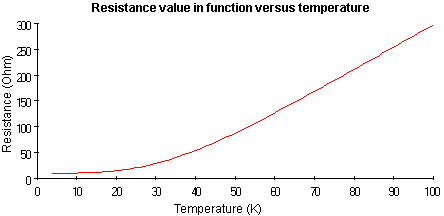Temperature Measurement in Low Temperatures
with Platinum Resistance Elements
Todays market presents an ever increasing number of RTD applications in low temperatures such as the deep-freezing storage of food-supplies, medical applications (e.g. storage of blood-preserves, and organs, etc.), laboratory-applications, and industrial uses such as liquification of high pure technical gases.
All these temperature applications require repeatable temperature control. There are currently many sensors that are approved for the measurement of low temperatures. Examples are semi-conductors, carbon-sensors, thermistors, thermocouples and Platinum resistance elements.
However many of these sensors manifest some significant deficiencies:
Small temperature-measuring-span - For wider temperature ranges, it is necessary to operate in a combination of different type of sensors in parallel. This in particular would apply to Ge-semi-conductors, carbon-sensors, and thermocouples.
Wide variation of the characteristic curve - This can cause the analyzing electronic to be changed when the sensors are replaced ( applies for carbon- Ge-sensors, and thermocouples).
Deterioration of the characteristic curve - The characteristic curve is greatly influenced under cyclical temperature exposure (applies to carbon-sensors and thermocouples).
These negative effects, for all applications over the temperature of 10K, can be avoided by using Platinum-temperature sensors. The individual characteristics of Platinum temperature sensors at low tempemperatures, both strengths and constraints are described below.
In addition to the geometrical dimensions, nominal resistance, and price one has to be aware of the following details for the application of Platinum temperature sensors in the low-temperature range:
Sensitivity (ΔR/ΔT) - This determins the temperature resolution and defines the temperature application at the lower end.
Repeatability - Accuracy of the measurement over a long term and over a large number of temperature cycles.
Response time - This determins the action and the time constant in the related control and safety-circuits.
Sensitivity (ΔR/ΔT)
The resistance of metals can be devided according to the Mattiesen-rule of constant, non-temperature dependant part, and a temperature-dependant part. The temperature dependant part changes almost linear with the temperature. Pure Platinum has a temperature coefficient measured between 0°C and 100°C.
The non-temperature dependant part is determined by contaminations in the crystal. The impurity atom embedded in the Platinum lattice causes an increase of the rest resistance. The embedding of impurity atoms are intentionally introduced in order to manufacture a standard-temperature-coefficient. The majority of the temperature applications are above 220K.
For this reason most users can disregard the affect of the rest resistance. The applications below 220 K manifest problems with the rest-resistance at temperatures below 30 K. Depending on the grade of doping of the Platinum lattice, you achieve rest-resistances of < 0,5 Ω to 2 Ω.
The resistance-curve flattens strongly in the range < 30 K. The unpredictable spread of the rest-resistance and the very strong flattening of the temperature characteristics demand an individual calibration of each resistance sensor in this measurement range.
Increasing the nominal value to 1000 Ω at 0°C facilitates for easier analysis because the resolution increases 10 times, compared with a Platinum 100 Ω element.

In the transition range of an almost linear resistance-temperature curve into the rest resistance, you observe that the sensitivity (ΔR/ΔT) strongly decreases and limits the measuring span. In order to carry out measurements below 30 K only one method is principally possible:
Individual calibration of each sensor element. When summarizing the characteristics of Platinum sensors it is necessary that three temperature ranges are viewed separately from one each other:
1. temperatures above 30K can be measured easily with Platinum temperature sensors.
2. temperatures of 10K to 30K can be measured with high-ohmic and individually calibrated Platinum temperature sensors.
3. temperatures below 10K are only to be measured with intense technical efforts.
Repeatability
All the known favourable characteristics regarding the stability of Platinum temperature sensors can be seen in low-temperature applications.
Platinum thin-film temperature resistance elements exhibit a so-called hysteresis if the sensors are applied over a wide temperature span
( <-50°C ... >+150°C ). This hysteresis effects a Platinum temperature sensor so that it changes its value at the calibration point if precipitated at low temperatures.
The shift of the temperature curve remains stable when using this temperature sensors only to a maximum of 150°C. The shift of the temperature curve reverses if the sensor is applied at higher temperatures.
The reason of this change is the effect resulting from the combination of the precious metal and the ceramic carrier materials. The different expansion coefficients causes a plastic deformation of the Platinum at low temperatures. This particular plastic deformation increases with decreasing temperature.
Temperature-cycles between the lowest temperature to be measured and room-temperature allow for consistency in measuring accuracy. The temperature sensors suitable for the low temperature technique are specifically conditioned (e.g. liquid nitrogen) in order to anticipate the shift of the characteristic curve.
All further cycles (at application) do not change the characteristics of the values. But it must be noted that those Cryogenic treated temperature sensors should not be exposed to temperatures above 150°C, in order to avoid a change in the curve.
Response time
The response time of the temperature sensors are influenced by several factors:
- Thermal mass
- Heat-transfer co-efficient
- Heat-dissipation through the connection leads
The response-time for the Platinum temperature sensors is determined according to DIN EN 60751 at room-temperature in air and in water. The heat transition co-efficient strongly decreases at low temperatures. Compared with room-temperature you achieve significantly longer response times.
The corrective factors for the heat-transfer co-efficient in different medias and varying media-temperatures are described in the VDI/VDE-guide-line #3522.
GEKON Trading GmbH
John-F-Kennedy-Str. 88 - D-63457 Hanau
+49 (0) 6181 956-270 -


